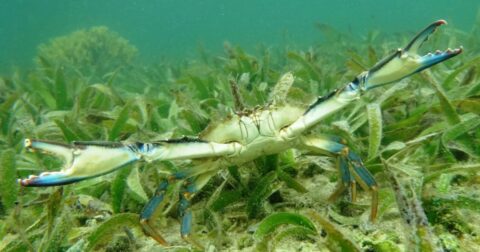Solutions
Iowa’s Clean Water Advocates Are Reclaiming the Past to Protect the Future
Climate•6 min read
Reported
Abandoned traps catch roughly 3.3 million crabs each year, on top of decimating seagrasses, coral and endangered whales.


Words by Grace Hussain
Thousands of people will flock to beaches this summer to enjoy the cool, salty water — but they might not know there’s a significant crisis facing the oceans. Millions of tons of abandoned, “ghost” fishing gear lurk beneath the waves, among them crab traps and pots that kill crabs and wreak havoc on other wildlife. Selected by National Oceanic and Atmospheric Administration (NOAA), a new program from William & Mary Virginia Institute of Marine Science (VIMS) aims to pioneer a first of its kind program to collect the abandoned gear.
Abandoned traps and pots are responsible for killing 3.3 million crabs each year in the Chesapeake Bay. Though numerous attempts to remove the ghost traps and pots from coastal waters around the country have been made, the new program represents the first nationally coordinated strategy, building on past efforts that successfully removed 34,000 traps locally.
Called Nationwide Fishing Trap, Removal, Assessment and Prevention Program, or TRAP for short — the new program is funded for four years with $8 million provided by NOAA. According to VIMS, this funding will be applied to removing “the pots and traps used to harvest crabs and lobsters, and establish a Derelict Trap Policy Innovation Lab to synthesize the collected data to inform prevention and mitigation policies at the state and federal levels.”
While the money is being directly awarded to VIMS, a large portion of it will be distributed to other entities via grants, and some has been set aside to fund Indigenous and commercial fishers removing traps.
The new program comes at a critical time for dropping crab populations. In the Alaskan Bering Sea, both the Bristol bay red king and Bering sea snow crab seasons were canceled due to low populations. The cancellation represents the first time that the season for the Bering sea snow crab will fail to open at all.
Other areas once home to large populations of crabs aren’t faring much better. Back across the continent in the Chesapeake Bay, this year’s estimated crab population continues the recent trend of being well below historical averages. However, the estimated 323 million crabs in the Bay represent an increase from 2022, when the population reached a historic low.
According to recent data released by NOAA, the Chesapeake Bay marine biome is heavily impacted by abandoned crab traps. Gathered data revealed that the derelict traps catch roughly 40 different species of non-target fish — in addition to the millions of crabs — annually. While the ghost traps are not the only stressor on crab populations, which can be decimated by industrial fishing aimed at other species, they do make a bad situation even worse.
The derelict traps have a massive impact on more than just crustaceans. The crab traps can also be damaging to seagrasses and coral, and harm other marine ecosystems. Destroying parts of sensitive marine habitats has lasting effects on an array of other species, even if they’re not caught directly by the trap. One of the primary threats to endangered whales are abandoned crab pots, for instance.
Ultimately, the driving force behind attempts to collect crab traps is to prop up the crabbing industry. The NOAA research focusing on the Chesapeake Bay found that collecting the traps in specific areas that are used most heavily resulted in a harvest increase of 38 million pounds over six years.
Like with many other invertebrates, people assume that crabs lack the ability to feel pain, or that they aren’t sentient. Research from the London School of Economics places this assumption to rest and provides recommendations to improve animal welfare for crabs across industries, including changes to the types of traps used.
“There is strong evidence of sentience in true crabs,” states the report authored by researchers at the London School of Economics, including having the nociceptors necessary to feel pain.
Following the release of the report, crabs, octopus and lobsters were all recognized as sentient beings within the British Animal Welfare (Sentience) Bill. Though the addition itself did not impact existing laws or industry, it does open the door for legislation ending common practices such as boiling these animals alive.
There are other recommendations for more humane handling to reduce crab suffering. Among these are the implementation of a declawing ban, finding alternatives to cutting crab claw tendons and banning the sale of live crabs to untrained handlers.